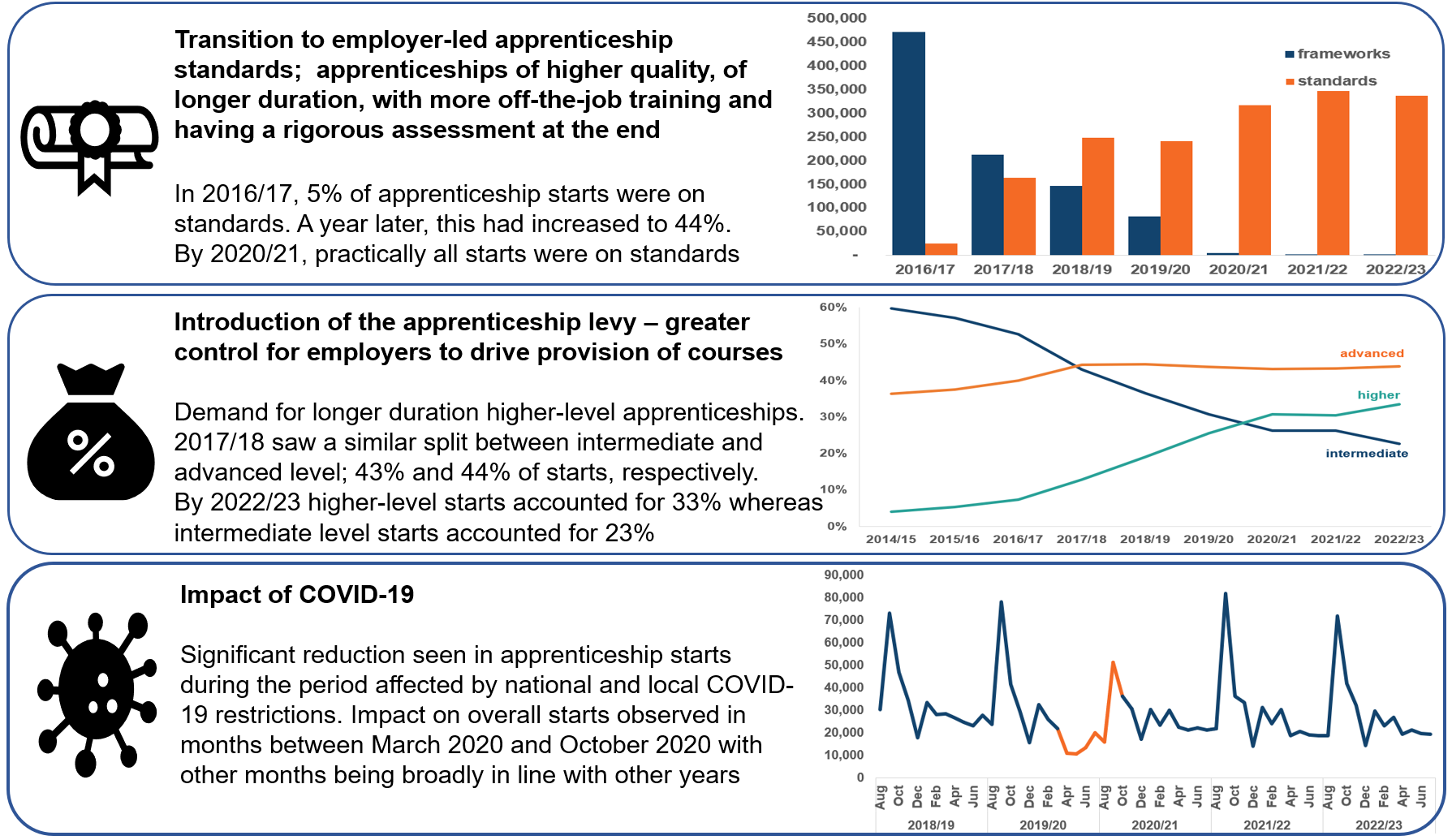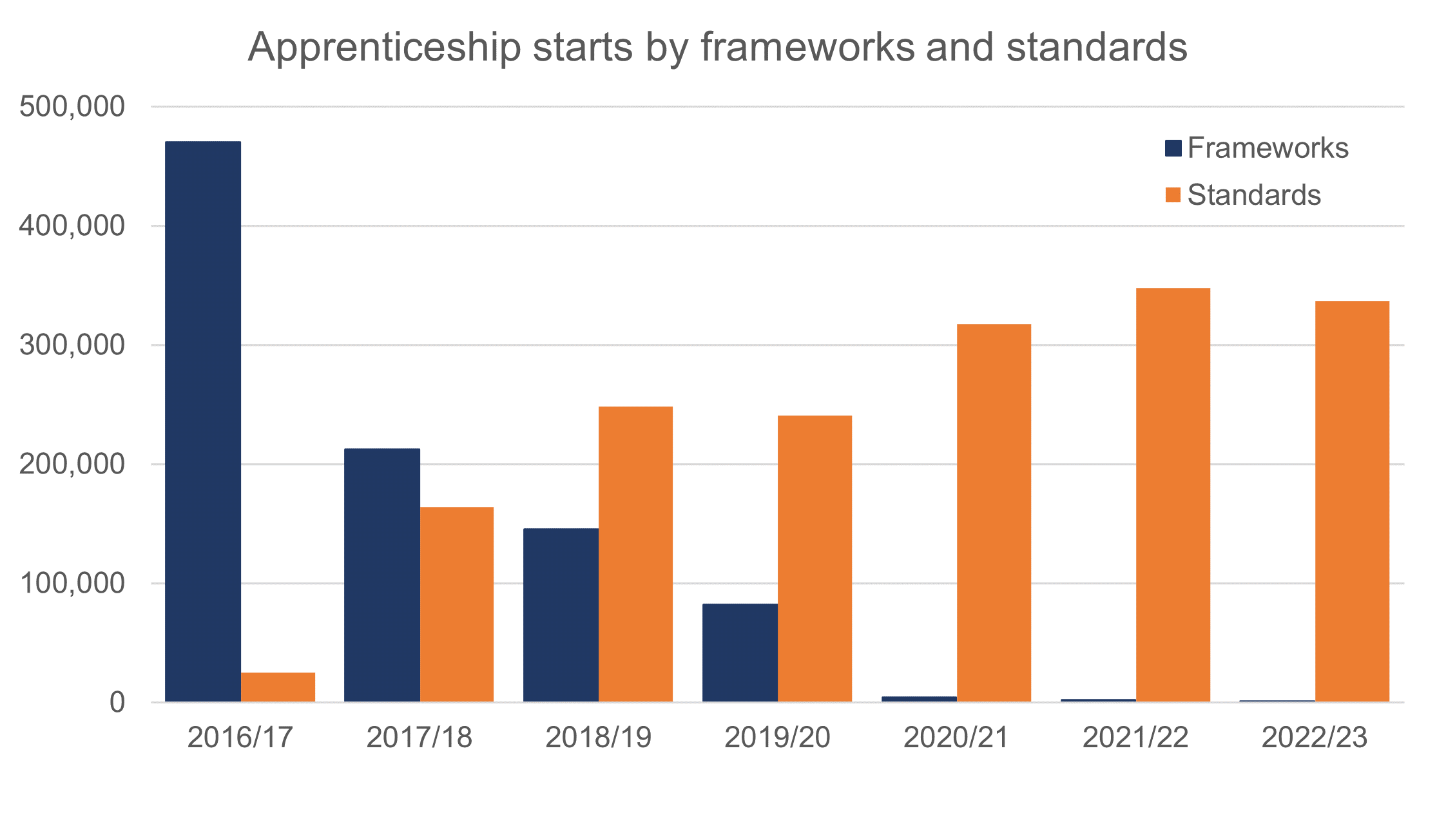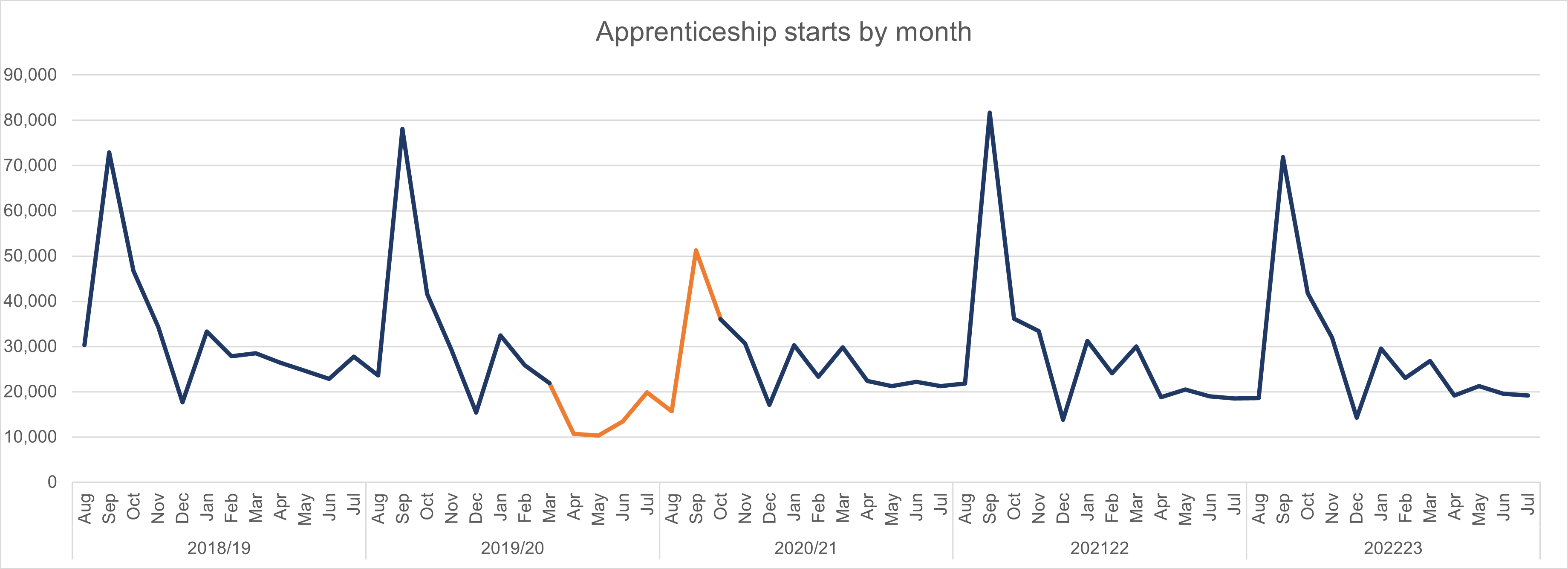The following statistics are classified as official statistics and have been produced in line with the Code of Practice for Statistics, rather than being classed as national statistics and accredited as such by the Office for Statistics Regulation (opens in new tab). The statistics are included for transparency purposes.
Data in this section refers to 2021/22 and was first published in March 2023. Data for 2022/23 is planned to be released in March 2024.
The National Achievement Rate Tables (NARTs) present detailed tables of provider level Qualification Achievement Rates (QARs) that we use for performance management and informed choice purposes. Additionally we provide some national summary tables to show overall performance in the sector with a three year time series to enable comparison of change in performance over time.
In March 2020, the Secretary of State announced that the summer 2020 exam series in England would be cancelled to help fight the spread of Coronavirus (COVID-19). This announcement also stated that Government will not publish any school, college or provider-level educational performance data based on tests, assessments or exams for the 2019/20 academic year.
In February 2021, given the continued disruption, it was confirmed this would also be the case for the 2020/21 academic year. As a consequence of the disruption to the assessment process, the government announced a change to its school and college accountability approach (opens in new tab), stating providers will not be held to account on the basis of exams and assessment data from summer 2020. This release will therefore only contain provider level data for 2021/22.
Headline figures at a national level are available to provide a three-year time series, showing data from 2019/20 to 2021/22. That historical data has not been re-calculated and is shown as originally published in March 2022.
Data for years prior to 2019/20 can be found in the Statistics: national achievement rates tables (opens in new tab) collection.
The overall apprenticeship achievement rate has seen a decrease of 4.3 percentage points between 2020/21 and 2021/22 whilst the achievement rate for apprenticeship standards has seen a decrease of 0.4 percentage points.
Changes in achievement rates are dependent on a combination of retention rates and pass rates. Pass rates have decreased by 0.6 percentage points between 2020/21 and 2021/22 whilst retention rates have decreased by 4.0 percentage points.
The apprenticeship achievement rate measure is additionally reliant on the persons continued employment and in some sectors there is higher churn so caution should be used interpreting simple averages because changes in provision mix across sectors will lead to change in overall averages.
Things you need to know about this release
The purpose of including this achievement rate data for 2019/20 and 2020/21 is to maintain the continuity of information and to provide context alongside the achievement volumes found elsewhere in this publication. It is important to maintain transparency by presenting the national level data for this cohort of learners whilst recognising the extraordinary circumstances under which apprenticeships were completed in 2019/20 and 2020/21, as a result of the Covid-19 pandemic.
A number of things will have impacted the data and as a result data should not be directly compared to data from previous years. For example there was an increase in the number of breaks in learning which meant learners being reported in a different year to the one in which they were expected to complete. Different sectors have been affected in different ways.
In 2018/19 only 6,000 learners were carried forward whereas 24,000 and 28,000 were carried forward in 2019/20 and 2020/21 respectively. For 2021/22 we estimate the number of learners being carried forward is 34,000. They have fallen out of scope for 2021/22 and will be included in a future publication.
Impact of the transition from Frameworks to Standards
When looking at achievement rates it is important to consider the impact of programme change in the nature of the provision resulting from the transition of frameworks to standards. Standards are designed to be more demanding than traditional frameworks. The assessment process is also more rigorous with a specific end point assessment phase following completion of training designed to ensure the apprentice is ready to do the job they have been trained for.
The proportion of learners on frameworks and standards has changed significantly since previous years. In 2019/20 the proportion of learners on standards stood at 46%. For 2021/22 the proportion has now reached 85%.
Apprenticeship achievement rates for individual standards and frameworks for 2021/22 can be found in the ‘Apprenticeship Achievement Rates Subject - Standards and Frameworks’ featured table in our create your own tables tool.
Impact of sector subject area
The mix of achievement rates across each sector subject area can be found to vary which can affect the national average, where figures could be found to be misleading.
Only Agriculture, Horticulture and Animal Care saw an increase in 2021/22, by 0.2 percentage points. All other sector subject areas have seen a decrease. The largest decreases, with significant volumes, were seen in Health, Public Services, and Care, decreasing by 7.8 percentage points, and Information and Communication Technology, decreasing by 7.7 percentage points.
For 2021/22 the sector subject areas with the highest achievement rates are Agriculture, horticulture, and animal care (62.4%), Education and Training (61.9%), Leisure and Tourism (59.5%). STEM subjects have an overall achievement rate of 57.3% where as non-STEM subjects have an overall achievement rate of 52%.
Background information
National achievement rate tables are based on underlying Qualification Achievement Rates (QAR) data. Information about the process surrounding QARs can be found here:
Introduction to Qualification Achievement Rates (QARs) (opens in new tab)
How rates are calculated
Information about how QARs are calculated can be found here :
Qualification achievement rates 2021 to 2022 (opens in new tab)
Overall apprenticeship achievement rates by learner characteristics
The figures in this section cover the achievement rates for those learners who are from ethnic minorities (excluding white minorities). Please note the figures for “White” include white minorities.
In 2021/22, learners from ethnic minorities (excluding white minorities) had an overall apprenticeship achievement rate of 48.3%, a decrease of 4.7 percentage points from 53.0% in 2020/21.
As is the case when looking into other learner attributes the variation in achievement rates by ethnicity is mainly driven by the mix of sector subject areas being undertaken. For 2021/22 this is driven by a large cohort volume of 10,850 for the Health, Public Services and Care sector (15.7% of all learners were from ethnic minorities (excluding white minorities)) and 11,320 for the Business, Administration and Law sector (14.4% of all learners were from ethnic minorities (excluding white minorities)) with overall achievement rates of 48.1% and 45.7% respectively. By comparison, only 8.1% of learners in the Engineering and Manufacturing Technologies sector were from ethnic minorities (excluding white minorities).
The sector with the highest achievement rate for learners from ethnic minorities (excluding white minorities) was Leisure, Travel and Tourism with 64.5%. The lowest achievement rate was for the Arts, Media and Publishing sector with 42.1%.
Caution should be used interpreting simple averages because differences in provision mix across sectors will lead to change in overall averages. Press the green ‘Explore data’ button above to look at the data by age, level, sector subject area.
Apprenticeship overall achievement rates by detailed level
Achievement rates at levels 6 and 7 increased in 2021/22 when compared to 2020/21. Achievement rates decreased at all other levels.
For data on individual providers for 2021/22 please see the featured table called ‘Apprenticeship achievement rates by provider’ in our create your own tables tool.
2021/22 is the first year in which a fair comparison can be drawn for apprenticeships supported by ASA levy funds. The levy was first introduced in 2017 but, given that achievement rates are calculated using a multiyear data set, 2021/22 is the first year in which significant volumes of those who would have started under the levy system can be observed.
Additional featured tables
The following featured tables offer more detailed breakdowns and combinations of characteristics and are available in our create your own tables tool:
Apprenticeship Achievement Rates by age and level
Apprenticeship Achievement Rates by individual standard / framework
Apprenticeship achievement Rates by provider
Apprenticeship Achievement Rates by provider type and level
To view achievement rates by provider, with provider type, please see the supporting ‘Apprenticeship Achievement Rates - By Provider with Provider Type’ file in the ‘Additional supporting files’ accordion.
Redactions
We have redacted two providers from our formal performance tables (NARTs) where we are unable to form a reliable QAR. This is done where the data we hold does not allow us to calculate a reliable estimate and therefore provides an unfair measure of performance. We publish headline information for these providers separately for transparency, but they do not constitute a formal QAR and should not be used to compare performance. The underpinning data is included in our national achievement rates to provide a complete view of performance. Details can be found in the ‘Apprenticeship Achievement Rates – Transparency Redactions.pdf’ supporting file in the ‘Additional supporting files’ accordion.
Traineeships
Positive destination rates have been calculated for Traineeships for the first time and are provided here for transparency. Users should note the caveats for these new rates that are based on provider information on destinations and how this compares with existing measures we publish in this release for traineeships on completions and conversion to apprenticeships and in the Outcome Based Success Measures release.
Traineeship positive destination rates are produced to provide a measure of performance that is aligned to other QAR measures for apprenticeships and education and training. In common with other QARs they count the total number of learners who were due to complete in the given year (the denominator). However for Traineeship we determine an achievement (the numerator) as being activity where a positive destination is recorded in the Individualised Learner Record rather than a successful pass of the programme or qualification entered.
Out of the 16,230 traineeships in 2021/22 56.0% had a positive destination recorded.
Points to note on how traineeships QARs are measured
The positive destinations method for traineeships is reliant on providers accurately being able to report destinations in the ILR. 56.0% were reported as going into employment or other forms of training including part time FE learning. A large number of traineeships, 44.0%, are currently reported with “not applicable” as their destination, and these are not counted as having a successful outcome. While many may not be applicable because they did not have a successful outcome, there will be cases where providers do not know the outcome and the learner did find employment or go into other learning.
Technical specifications for how achievement rates are calculated can be found in the Qualification achievement rates 2021 to 2022 (opens in new tab) guidance.
Further information on Traineeship funding rules including how the performance management process works can be found in the ESFA funding for traineeships (opens in new tab) guidance.
Points to note on how traineeship QARs compare with other data published
In the Traineeship section of this release we publish total starts and how many of these completed. This will vary from the QAR measure because this counts all starts observed in the year including those due to complete in the following year. This measure also allows for COVID flexibilities.
In the Traineeship section of this release we also publish conversions to apprenticeships which for 2020/21 were 20.6% This is based on administrative data and takes all the known starts for a year and tracks any learner found in an apprenticeship in the following year. The QAR method only relies on what providers have captured directly or from a learner so this administrative measure is a more complete observation of who goes onto apprenticeships.
The Outcome Based Success Measures statistics publication uses the LEO dataset that brings together DfE, HMRC and DWP records to show positive outcomes over the October to March period after the year a learner completes. The latest data for 2019/20 completers shows 59% had a sustained positive destination and a further 23% having a positive destination that was not sustained (which will include those doing shorter periods of further learning or employment).
Additional featured tables
The following featured tables offer more detailed breakdowns and combinations of characteristics and are available in our create your own tables tool:
Traineeship Positive Destinations by provider



